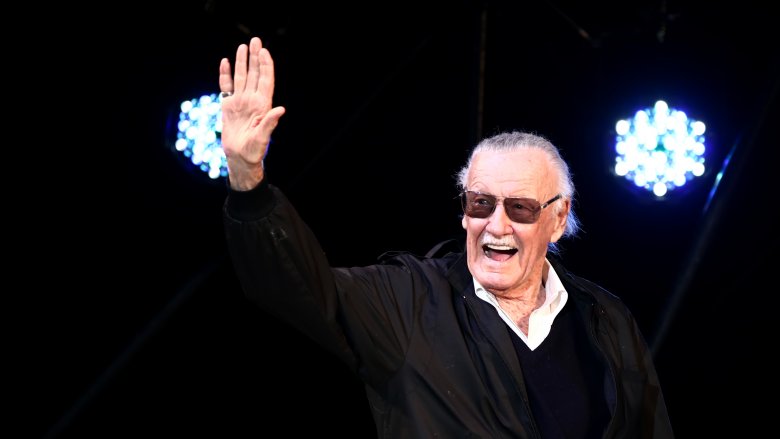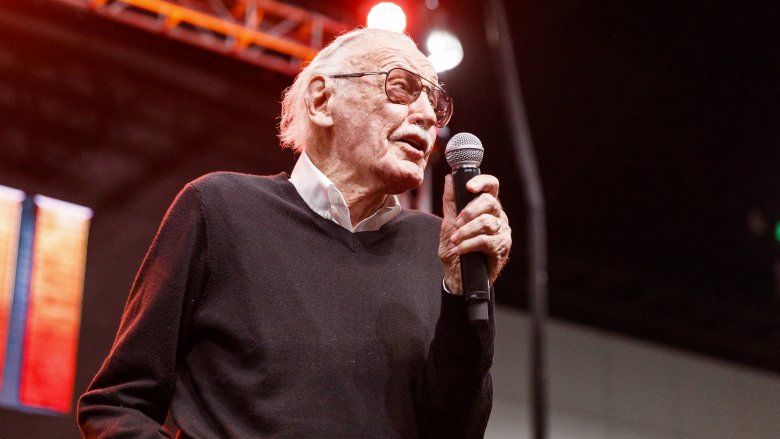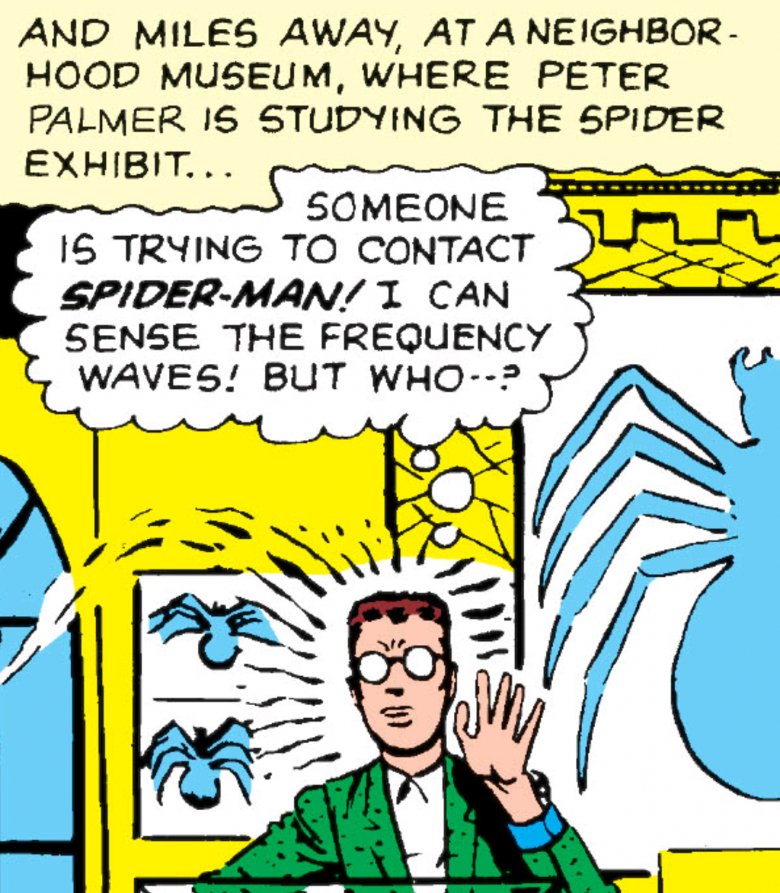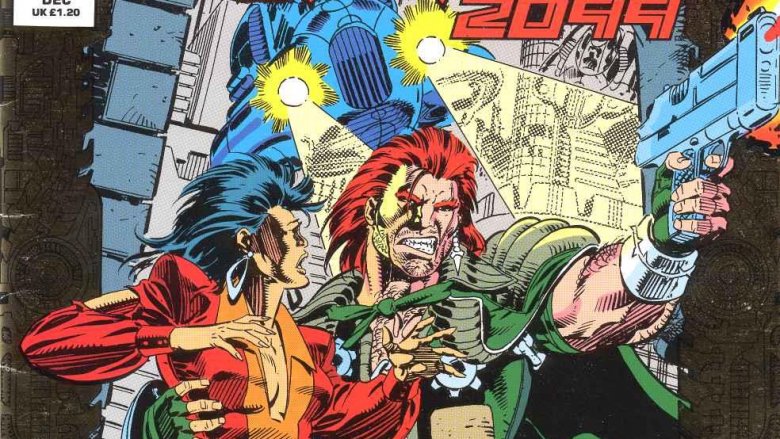False Facts About Stan Lee You Always Believed Were True
Face front, True Believers! Even if you've never read a comic book, there's a solid chance you know the name Stan "the Man" Lee. If you approached a random stranger on the street and asked them to name as many comic book creators that they could, they'd probably say something like "Stan Lee and the guy who does Snoopy." He is the name associated with comic books. Excelsior!
It would be hard to overstate how important Stan Lee is to comics history. His bombastic persona, which came through not only in his scripting but also his interactions with fans and promotions of Marvel as a brand, revolutionized comics and turned Marvel into the top publisher in American comics since 1969. He helped bring to life hundreds of characters that have starred in decades of comics and now feature in films that scored almost $11 billion at the box office from 2008 through 2015 alone.
However, if you view Stan Lee as just a jolly, catchphrase-spewing, cameo-making grandpa who founded Marvel Comics and created Spider-Man and the Hulk and Captain America and Deadpool and Superman, all of whom he still writes today as the President-for-Life of Marvel Comics, there are a few things we need to clear up. Don't be an Irving Forbush, effendi! Read on to learn the truth! Nuff said!
His real name is Stan Lee
Usually the first fact you learn about a person is their name, and when you first heard the name Stan Lee, there's a good chance your reaction was, "Wow, is that his real name?" Well, technically, the answer is no, it's not his real name. (It is, however, the real name of a Kentucky state representative.)
As noted in his write-up by Biography, Stan Lee's birth name was Stanley Martin Lieber, the son of Romanian immigrants Jack and Celia Lieber. That means he's definitely not, as some young comics fans might believe, related to superstar artist and current DC Comics co-publisher Jim Lee, and neither one is related to award-winning artist Jae Lee. However, Stan Lee is related to Larry Lieber, his younger brother with whom he would co-write early adventures of Thor, Iron Man, and Ant-Man, among others, and who has drawn the syndicated Amazing Spider-Man newspaper strip from Stan's scripts since 1986.
Lee did, however, have his name legally changed from Stanley Martin Lieber to Stan Lee, because, as he explains in his own words, he became better known by his pen name than his birth name, and this caused confusion when, for example, he handed a credit card with the name Lieber on it to a shop owner who knew him as "Mr. Lee." So while "Stan Lee" isn't his birth name, it's been his legal name for decades.
He had a calling to write comics
It was incredibly common for comics creators, especially in the early days of the medium, to use pen names to sign their work, when they even signed their work at all. The reasons for this might vary: embarrassment at working in what was (and to some degree still is) seen as a lesser artistic medium, trying to mask an ethnic-sounding name at a time when such names were less palatable to some Americans, or — maybe best of all — hiding from employers that you were working for a competing publisher.
Gil Kane, for example, was born Eli Katz; Ross Andru was Rossolav Andruskevitch; Fletcher Hanks signed his work as Henry Fletcher, Barclay Flagg, or Hank Christy; Lou Fine drew the Ray as E. Lectron. Jacob Kurtzberg tried out names like Jack Curtiss, Jack Kurtz, and Lance Kirby before deciding on the name that still rings out as the King of the Comics, Jack Kirby. Even modern creators like Matt Fraction, Chip Zdarsky, and Tula Lotay use pen names for their comics.
Stan Lee, according to a frequently told story recounted here by Vulture, used a pen name to write comics because he was saving his real name for when he could graduate from writing comics to writing more serious literature. At the time, writing comics for him was just a job like writing obituaries had been. He just never moved on from comics, and so the name "Stan Lee" stuck.
He's the man who made Marvel Comics
While Stan Lee is the name most associated with Marvel Comics, he's not the one who started the company. Marvel began in 1939 as Timely Comics (though it did publish a book called Marvel Comics), the creation of pulp magazine publisher Martin Goodman, who was looking to expand into the then-new world of comic book publishing. In 1940, Goodman was looking for an office assistant, and so, as Lee explains, Goodman hired his wife's teenage cousin to be a gofer. That teen, of course, was Lee.
When Lee arrived at the Timely offices, there were two men there: Joe Simon, the editor, and Jack Kirby, the artist. (Timely bought many of its stories from other companies.) These two men created Timely's first in-house hit, Captain America, of whom you may have heard. While Lee was brought in to be an assistant who, as Vulture describes, was "prone to leaping around the offices while playing an ocarina," he was soon writing for the comics himself. His first story was, naturally, a Captain America joint: a prose story in the pages of Captain America Comics #3 called "Captain America Foils the Traitor's Revenge."
So while Lee wasn't the founder of Marvel Comics or even its first editor (though he was made editor at the tender age of 19 after Simon and Kirby left for DC when Timely cheated them out of Captain America profits), he was there from early days thanks to a job his cousin's husband gave him.
He created Spider-Man when he saw a fly crawling on a wall
One of Lee's most repeated anecdotes is that after he had written stories for the Fantastic Four, the Hulk, and Thor, he was having a hard time thinking of a new set of powers to base a superhero concept around. He looked up, saw a fly climbing up a wall, and remarked to himself something like, "Wouldn't it be groovy if a superhero could stick to a wall like an insect?" Then he ran through a litany of possible names, like Fly-Man and Mosquito-Man and so on, until he finally struck upon Spider-Man, and an icon was born! Excelsior!
Except there's basically no chance that's actually true. The actual history of Spider-Man's creation is somewhat mysterious and definitely contentious, with Lee, Steve Ditko, and Jack Kirby all claiming to be the character's creator. Kirby's inclusion on this list might be a surprise to those who know that Ditko drew the earliest Spider-Man stories, but Kirby was the original pick to draw the arachnid hero, and what little evidence remains suggests the first version of the hero owed quite a bit to an unpublished Simon and Kirby concept called the Silver Spider, not to mention the actually-published hero the pair did for Archie Comics called the Fly. Even Lee admits in his autobiography he doubts his own memory of his fly-on-the-wall story and cites the pulp hero the Spider as an inspiration.
He created all of Marvel's most famous characters single-handedly
Stan Lee has made a cameo appearance in nearly every Marvel movie and TV show — even those not produced by Marvel Studios — and why shouldn't he? He created all of Marvel's classic characters, like Captain America, Wolverine, Deadpool, and the Guardians of the Galaxy, so he definitely deserves a spot in their movies as a tribute to all his groundbreaking work on those characters.
You probably don't need to be told that Lee didn't create literally every character Marvel has ever published (though maybe you do?), but the more serious issue is that Lee claiming sole credit for Marvel's most iconic heroes — Spider-Man, the Fantastic Four, the Hulk, the X-Men, and so on – does a serious disservice to his collaborators like Kirby and Ditko, who, in many cases, did the lion's share of the character creation.
While who exactly did what in the creation of Marvel's biggest characters is likely lost to history, it's not hard to see parallels between, say, Kirby's previous work on DC's Challengers of the Unknown and Fantastic Four, or his use of Thor as a villain in Sandman before he appeared as a hero for Marvel. Also, it's hard to argue that the visual design of a character is not an essential part of its success.
In any case, it's difficult to understand why Stan Lee got a cameo in Captain America and Joe Simon, his actual creator, didn't.
He wrote every Marvel Comic in the early days
The most common method for writing a comic book is what's called full script: The writer breaks down the story page by page, panel by panel, laying out the action and dialogue for each panel in the story. This is true now, and it was true in the 1960s, when Marvel was quickly becoming a breakout success due to the superhero creations of Lee, Kirby, Ditko, and others. However, at this time, Lee was both Marvel's only editor and the writer on every title it published. This meant he didn't have time to write a full script for every book, which led to the creation of what has become known as "the Marvel method."
As traditionally defined, the Marvel method means the writer develops a story idea or plot that is passed on to the artist, who then decides how to break that plot down into pages and panels. The writer then comes back and adds dialogue to the story art. However, as this detailed look at the Marvel method shows, Lee's process was something closer to suggesting a villain or conflict, then leaving the artist to plot and draw the entire story, with Lee simply adding dialogue and captions later. (If you look at Kirby's original art, you can see he even left notes for suggested dialogue in the margins of his pages.)
It's definitely inaccurate to say Lee created all of Marvel's characters, and it's not even accurate to say he wrote all the stories.
He gave his characters iconic, alliterative names as a Marvel trademark
Marvel Comics managed to stand out from the pack in the 1960s thanks to Stan's knack for bombastic dialogue and bold characterization that really made his characters sing compared to the relatively interchangeable personalities of the Justice League, for example. Another stylistic flair of Stan's — so successful that it's become a cliche of the superhero genre — is the prominent use of alliterative alter egos among Marvel heroes: Peter Parker, Bruce Banner, Reed Richards, Sue Storm, Matt Murdock, Scott Summers, and so on. (Compare, for example, Bruce Wayne, Diana Prince, Hal Jordan, and Barry Allen. Clark Kent is an arguable exception.)
This move wasn't a decision to help put Marvel's characters on the map, however. Marvel's heroes got memorable names because, as Lee himself admits, he has a terrible memory, and the alliterative names helped him remember his own characters. If he could remember "Murdock," he was more likely to remember "Matt."
This trick didn't always work out, though. Besides the fact that Spider-Man is called "Peter Palmer" twice in the first issue of his solo title, Lee once hecked up a name so bad it affected canon. For several issues in the 1960s, Lee referred to the Hulk's alter ego as "Bob Banner" instead of "Bruce Banner," and when called out on his mistake in the letters page of Fantastic Four, he said simply that Hulk's full name was Robert Bruce Banner, which has been his canonical name ever since.
He's a lifelong Marvel company man
Thanks to the fact that Lee wrote or co-wrote all of the most important Marvel comics of its early days and really defined its style and tone with the jivey, huckster-like voice he used for his scripting, letters pages, and editorials like "Stan's Soapbox," it's very easy to completely equate the man with the company, especially when he so easily slipped into the role of its public face compared to Kirby, who would rather be working than self-promoting, and Ditko, who joked he would rather jump out a window than show his face in public. Plus there's the fact that "Stan Lee presents" appeared before the title of every Marvel Comics story for decades.
But the fact is, Lee hasn't been the primary driving force behind Marvel in many, many years. As described by Vulture, he became president and publisher of Marvel in 1972 and more or less walked away from writing Marvel comics, with his final issues of Spider-Man and Fantastic Four coming out that year. He even stepped out of the role of president pretty quickly, preferring to focus on the more creative opportunities afforded by his position as publisher. However, by 1980, he had headed to Hollywood in an attempt to develop Marvel properties as movies and TV shows. These days he says of himself, "I have no standing at Marvel where I decide what projects get made or who gets hired. ... Mostly I'm just a pretty face they keep for the public."
He's got a great relationship with Marvel
Given their long association and his continued role as the public face of the company for decades, it would be easy to assume that Marvel and Stan Lee have always had a great relationship, such as you might have with your very loud grandfather who likes to talk about how he invented Spider-Man all by himself. Unfortunately, that hasn't always been the case.
As Vulture explains, when Marvel was dealing with bankruptcy proceedings in 1998, Lee was able to renegotiate his contract to the tune of a six-figure salary just to be a figurehead, plus a shocking 10 percent of any profits Marvel made on movie or TV projects. Of course, this was 1998, a decade before Marvel properties would soon swallow Hollywood whole. So of course by 2002, Lee had sued Marvel for not honoring this portion of the agreement. (One commentator said it was like Colonel Sanders suing KFC, but of course, that happened, too.) Marvel would settle that suit in 2005, but there would be a number of others, including a 2013 suit in which Lee sought ownership of the characters he co-created, but this case was dismissed.
On the topic of Stan Lee lawsuits, Lee created a new company in 1998 called Stan Lee Media and developed all sorts of terrible projects, so the company sued him in 2007. It has nothing to do with Marvel, but it's pretty weird.
There's no off button on the genius machine
One argument against the idea that Stan Lee was the driving force behind Marvel's greatest hits is to compare what he created with Kirby and Ditko to what they created apart. Together, they created the Fantastic Four, the Avengers, Spider-Man, the X-Men, Daredevil, Dr. Strange, and many others. Solo Kirby created the Demon, Kamandi, Machine Man, Devil Dinosaur, and the New Gods — including Orion, Mister Miracle, and Darkseid. Ditko created the second Blue Beetle, the Question, the Creeper, Shade the Changing Man, and Squirrel Girl.
Meanwhile, in his time since leaving his writing position at Marvel, Lee has created such works as Ravage 2099, the animated TV series Stripperella, and "The Backstreet Project," in which he turned the Backstreet Boys into superheroes. Then there was a 2001 project called "Just Imagine..." that teamed Lee up with iconic artists to picture an alternate universe in which Stan Lee had created DC's most iconic heroes and made them much, much worse. In other projects, he turned the Wu-Tang Clan, Ringo Starr, and some hockey players into superheroes.
It's not just his latter-day projects that weren't all winners, either. Lee had a penchant for attempting the kind of risque humor found in Playboy magazine in such comics as Little Annie Fanny. One such failed attempt was the 1968 magazine The Adventures of Pussycat, featuring the titular Pussycat, agent of S.C.O.R.E., battling the evil agents of L.U.S.T. Oh, well. They can't all be "If This Be My Destiny."










